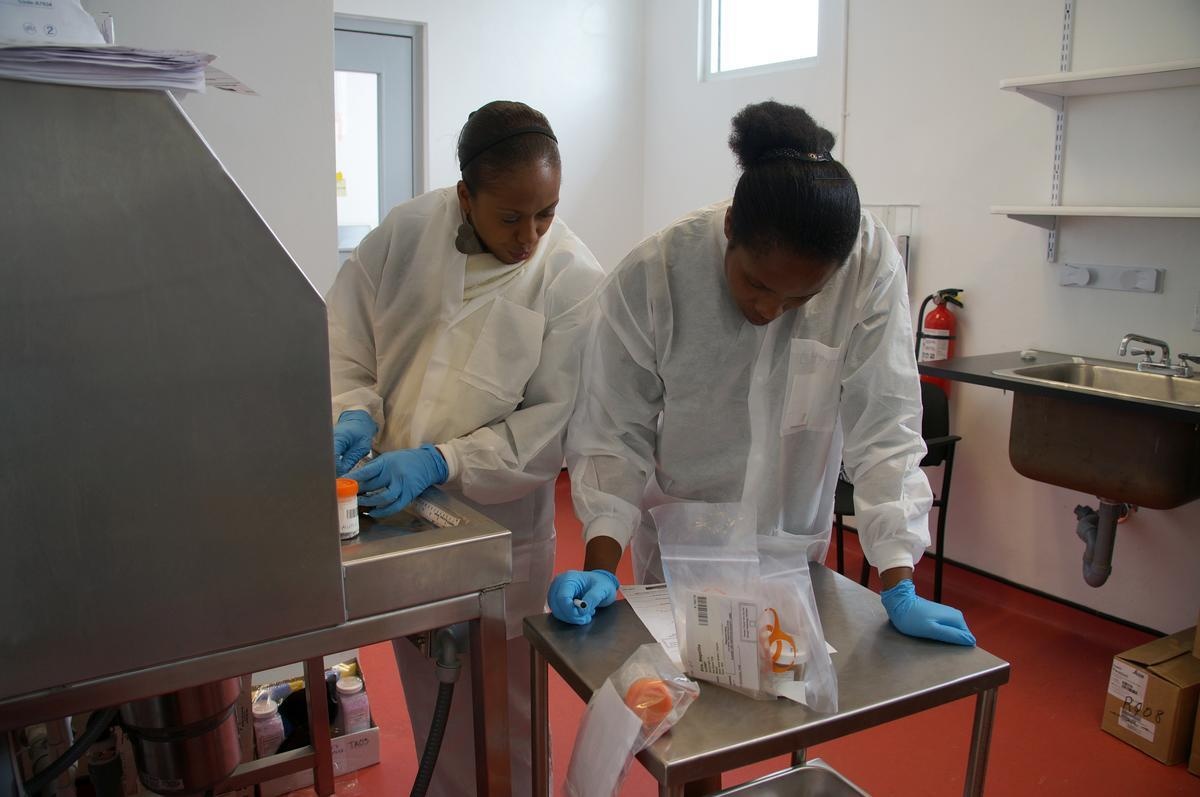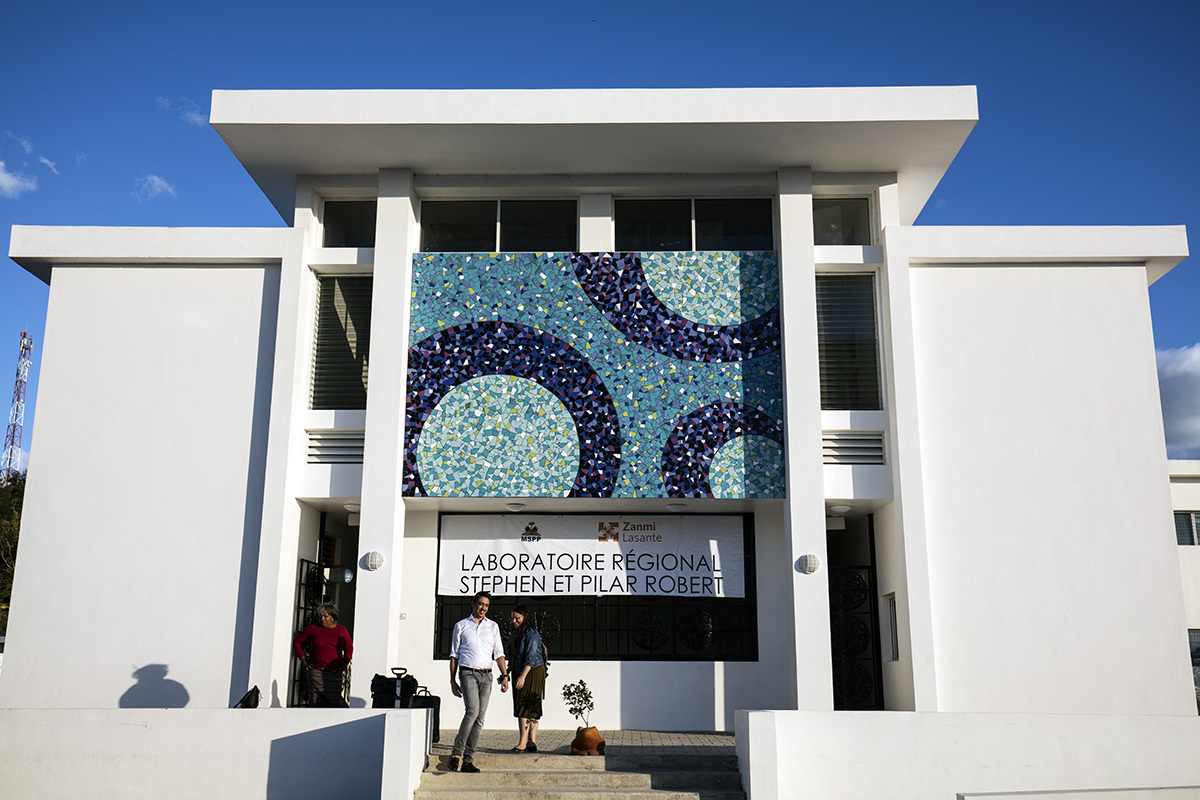The Evolution of a Pathology Lab in Haiti
New director boosts training, envisions residency program to improve cancer diagnoses, treatment
Posted on Jan 30, 2023

In November, when Dr. Marie Djenane José arrived for her first day on the job as director of the pathology lab at Hôpital Universitaire de Mirebalais (HUM), she was surprised to find a fairly well-equipped laboratory that met international standards.
The problem wasn’t the equipment, she said, but the lack of sufficient training for the technicians operating that equipment. This training gap, and other issues, led to a backlog of more than 500 specimens awaiting macroscopy, the slicing and processing of tissue samples so they can be examined on a slide for cancer or other diseases. The backlog was exacerbated by the resignation of a previous pathologist months earlier and a chaotic system for identifying tissue samples awaiting analysis.
José sprung to action.
Her first move was to triage the specimens, prioritizing which, among the oncology, gynecology, and surgery cases, were possible cancers or other diseases requiring immediate attention.
Then, she developed a plan to improve the technicians’ training so they could take on some of the critical work of the pathology lab, including a more in-depth study of human anatomy, tissue analysis, and the art of slicing and dicing, called “grossing.”
A Dearth of Pathologists
Her vision, José said, is to lay the groundwork for a residency program in pathology at HUM. With about six pathologists in all of Haiti, a country of 13 million people, “the country needs it,” she said. Indeed, delays in cancer diagnoses can mean the difference between lifesaving treatment or death, if tumors grow or cancer spreads while patients await medical interventions.
A future pathology residency would add to a number of residency programs at HUM, the teaching hospital run by Zanmi Lasante, Partners In Health’s sister organization in Haiti, including in emergency medicine, surgery, internal and family medicine and obstetrics and gynecology.
Prior to José’s arrival, HUM was relying on a patchwork system of pathology that, as one doctor put it, “wasn’t perfect or permanent…but a mini-miracle in the context of everything happening in Haiti,” including escalating chaos, violence, kidnappings, and a lack of resources from fuel to electricity that impacted all departments.
HUM’s pathology lab, which opened in 2016 within the Stephen Robert and Pilar Crespi Robert Regional Reference Laboratory, helped accelerate cancer diagnoses by allowing many tissue samples to be analyzed locally, rather than mailed to hospitals in Boston, where volunteer pathologists reviewed and diagnosed the biopsied samples.

A Telepathology Fix
Expectations among doctors and technicians rose when a tissue scanning machine was donated and delivered in 2019 to the pathology lab by the American Society for Clinical Pathology, arranged by its former chief medical officer, Dr. Dan Milner, who, with others, had consulted on the original pathology lab design. Milner said the scanner couldn’t be installed until 2021, when a visitor was able to travel to Haiti to support the process.
The problem, yet again, was training: no one knew how to operate the machine.
Frustrated that patients were waiting far too long for diagnoses, Rebecca Henderson, a University of Florida medical student, anthropologist, and long-time volunteer at HUM, taught herself how to operate the scanner and then trained several HUM staff in the basics. Henderson relied on 24/7 technical support from the scanner’s manufacturer when it broke or bewildered staff, she said. That support allowed the establishment of a rudimentary, but functional, telepathology system, anchored by the Haitian team.
"The technicians took on the challenge of mastering a difficult new piece of technology, made more difficult by Haiti's fragile electric grid and difficult internet infrastructure,” Henderson said.
HUM technicians started preparing and scanning tissue sample so that pathologists at Brigham and Women’s Hospital in Boston, which has a long-standing collaboration with PIH as part of the Global Health Delivery Partnership, could read and analyze them. Last year, for instance, more than 1,000 tissue samples were viewed by the Boston pathologists, said Dr. Jane E. Brock, chief of breast pathology division at Brigham and Women’s, who leads the team assisting HUM. Nearly half the tissue samples were cancerous, Brock said, most of them breast cancer, or cervical cancer, which are by far the most prevalent cancers for women in Haiti, according to the WHO’s International Agency for Research on Cancer.
The current system still involves mailing certain tissue samples to Boston. That’s because breast cancer requires more complex evaluation, what’s known as immunohistochemistry, a special process of staining that shows whether the cancer cells have certain hormone receptors, which can be crucial in determining a treatment plan. That means every breast tissue sample must be shipped to Boston for analysis in order to determine what treatment options to pursue. This can take several weeks for a complete diagnosis.
Still, Brock said, telepathology means that what used to take months, now takes weeks.
“Without the Boston pathologists,” said José, “I believe the [HUM] lab would have been totally dysfunctional.” Ultimately, with their additional training, HUM technicians will be handling the tissue samples while José and future Haitian residents will be able to analyze more routine cases, and only the very complex cases will need the Boston pathologists.
Top-Notch Training
José has seen up close the difference that top-notch training can make. She completed her medical studies at the Université Notre Dame d'Haïti and pursued a residency program in pathological anatomy at the Hospital of the State University of Haiti, which, she said, “has serious problems of equipment, infrastructure, supply.”
Subsequently, José won scholarships in Martinique and Lille, France, at university hospitals equipped with state-of-the-art laboratories with immunohistochemistry and genetics.
“I was able to see the world of difference between these laboratories and those we had at the time in terms of infrastructure,” she said. “The HUM laboratory has at least a standard basis but requires more equipment and trained personnel. I dream that Haiti can have a pathology laboratory worthy of the name to conduct cancer research with a Haitian tumor bank.”
This dream aligns with PIH’s mission to offer “a preferential option for the poor.” But sometimes it takes time to get there. For people with cancer in Haiti, for example, there is no radiation treatment, and some of the newest, most effective chemotherapy drugs are financially out of reach. Still, cancer care at HUM has radically improved over the years, said Dr. Joarly Lormil, HUM’s chief of oncology, who recalls when he was a resident, and whole specimens, indeed every specimen, had to be sent by mail to Boston. “But hopefully,” he said, “with this new team and the current momentum, things will improve considerably.”
One thing that has already improved is the training and communications. Chantale Bellevue and Myrlene Mompremier worked for HUM in various capacities before entering the field of pathology; Taina Saint Jean, a medical assistant, is also studying to become a pathology technician.
In November 2022, Bellevue traveled to Boston for additional training, working with pathologists, including two who spoke Haitian Kreyol, to learn the latest techniques. This training, Bellevue said, “taught me how to do my job better…[and] bring those skills back and make our lab stronger.”
More training came by way of physicians at the University of Pennsylvania’s Perelman School of Medicine, who developed simple visual guides for macroscopy for the HUM technicians.
Still, said Marcellus: “Our training isn’t finished. It’s always continuing…and with telepathology, the patients can get their results so much more quickly.”
Faster Diagnoses
More support is needed. Lormil said in addition to faster turnaround time for specimens in oncology, a systematic method of entering pathology reports onto the digital electronic medical record is critical. And, he said, he’s eager to start using available technology, such as a GeneXpert platform cartridge that can perform all of the immunohistochemistry tests needed for a personalized breast cancer diagnosis on site.
Arranging for the distribution of these cartridges to HUM is underway.
“I'm really excited about the momentum we have in pathology,” Lormil said. “And I hope that we will push it further. There are fewer and fewer pathologists in Port-au-Prince, and access for patients is increasingly difficult. It imposes on us, I believe, a moral duty to provide these services, with the highest possible standard.”

